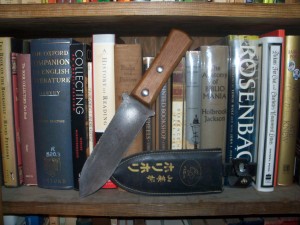We speak lovingly today of Japanese digging knives (Hori Hori). A garden tool I was unaware of before purchasing mine a decade back from Garrett Wade. The knives vary slightly in size and steel composition, and we have several. The blade is concave, about 6.5 inches long with one serrated side. It has a 5 inch wood handle. The edge and point are sharp and taper to a thick carbon steel body. The tang extends another 4 inches into the handle and is attached with two rivets.
The knife typically is sold with a leather sheaf. And on days devoted to the garden the knife remains attached in its sheaf on my hip when not being used. The digging knife has a real heft that is a pleasure to hold. The tapered point and blade edge, combined with the sturdiness of the design, cuts through all soil types. The serrated edge allows you to cut through small roots. Mine gets used primarily for planting transplants and removing stubborn weeds like plantains. It is also the tool that gets used on most foraging expeditions for wild herbs, perfect for digging out that six inch dandelion taproot.
I prefer the warmth and softness of the carbon steel to the stainless steel blades. They are easier to sharpen but do require more maintenance. To me that is an important and desirable trait. Stainless steel seems to invite a careless consumerist approach to tools, buy it and ignore it. Having a good tool is a partnership. And it only seems right to return its favors with a little linseed oil to the handle and a bit of machine oil on the blade.
…………………………………………………………………………………………..
Reading this weekend: The New Agrarian Mind: the movement toward decentralist thought in twentieth-century America by Allan Carlson. And Solstice and other poems by Robinson Jeffers. The latter is a real find, a nice first edition of the 1935 issue with dust jacket. (These things do matter)
